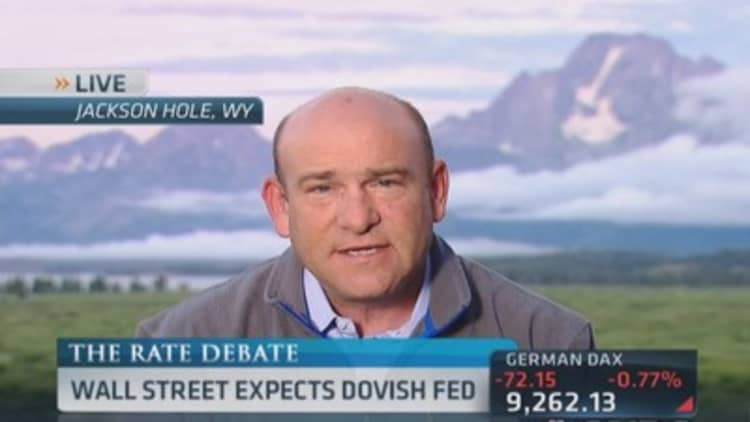
Wall Street expects the Federal Reserve to be so dovish that the coming round of interest rate hikes won't begin until the middle of next year and won't end until the next president is in office for nearly a year.
A special CNBC Fed Survey, prepared ahead of the central bank's annual meeting in Jackson Hole, Wyoming, found that market participants expect the coming rate hike cycle to end in the fourth quarter of 2017 at 3.16 percent. That would be the lowest final or terminal rate ever. It would beat the next lowest—the rate hikes in 2004 through 2006 that ended at 5.25 percent—by more than 2 percentage points.

The 36 survey respondents, who include economists, fund managers and analysts, on average believe it will take 30 months from the first rate hike to the last, nine months longer than the average rate hike cycle since 1983. The first rate hike isn't expected until July 2015, a month earlier than the prior survey. The 3 percentage point increase is about average compared to other rate hike cycles since 1983.
"The Fed is going to move very slowly," Wells Fargo Advisors' Scott Wren wrote in a response to the survey. "The Street's expectations for economic growth were way too high coming into the year. This modest growth/modest inflation environment is unlikely to change."
Read More FOMC minutes a market diversion until Jackson Hole
The survey outlook is in line with comments from Fed officials that there is no rush to raise rates and that, when hikes begin, they will be gradual and stop at a lower rate than in previous cycles. But the average of forecasts of Fed officials for the "long-run" fed funds rate is 3.75 percent, above the 3.16 percent forecast in the CNBC survey.
Meanwhile, survey respondents don't anticipate much action out of the Jackson Hole conference as far as new rate guidance is concerned. Two-thirds expect Fed Chair Janet Yellen to signal a neutral tone at her Friday morning speech compared to her previous stance, while 31 percent believe it will be more dovish. There is more uncertainty about the tone of the research papers that will be delivered and the media coverage, with 26 percent believing that they will be more hawkish, 26 percent saying more dovish and 46 percent expect them to be neutral.
Yellen is scheduled to speak on the conference's main topic, labor markets, and could offer a defense of her views that there is considerable slack in labor markets. Several academics have already suggested there is less slack than the Fed believes.
More on Wall Street embrace that view, but overwhelming agreement remains that there is slack in labor markets. In the current survey, 74 percent said there is a considerable or modest amount of labor slack relative to an economy operating at full potential, down from 84 percent in July. And 20 percent now say there is less slack—that is, the job market is tight—compared with 12 percent in the prior survey.
Read More
"The economy has seen 6 straight job reports over 200k (for the first time since 1997) and job openings are the highest since 2001," wrote Rob Morgan of V2V Associates. "The job market seems to be hitting the proverbial 'virtuous' cycle that will allow the Fed to raise rates sooner than the market expects."
Survey respondents are divided on whether the Fed is behind the curve. A considerable 46 percent think Fed policy is too easy now, compared with 49 percent who think it's just right.
"Mrs. Yellen is now the Sandman, (and) has been masterful at keeping investors in their dream state," wrote Tony Crescenzi, a market strategist with Pimco.
Read More
"Whether Janet Yellen has enough magic sand to keep investors calm—to suppress interest rate volatility and keep financial markets stable more generally—remains to be seen, however. It will become more difficult the closer unemployment and inflation move toward the Fed's targets. Yet it won't be that difficult, because in PIMCO's New Neutral thesis the Fed won't raise interest rates as much as it has historically. We believe the neutral policy rate is today 2 percent instead of the old 4 percent."
—By CNBC's Steve Liesman


